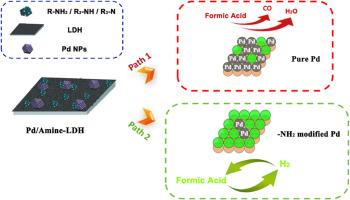在层状双氢氧化物上构造钯纳米粒子和氨基官能团制备双官能团产氢/储氢催化剂
IF 8.3
2区 工程技术
Q1 CHEMISTRY, PHYSICAL
引用次数: 0
摘要
利用甲酸(FA)作为高效H2介质,通过FA与CO2的转化,近年来受到广泛关注。本研究采用传统浸渍法制备了不同类型胺基(伯胺、仲胺和叔胺)接枝的层状双氢氧化物介孔材料。伯胺成为室温FA脱氢法制备初始TOF为1250 h−1的超细Pd纳米粒子的重要参数。同时,密度泛函理论(DFT)计算验证了在2 nm处控制Pd位可以有效地加速氢的形成,避免脱水反应的发生。后续在pd基层状双氢氧化物催化剂上将CO2加氢成甲酸/甲酸,完成H2相互转化循环的TOF大于100 h−1。这些发现将对氢气生成/储存化学和二氧化碳利用经济领域产生重大影响。本文章由计算机程序翻译,如有差异,请以英文原文为准。

Preparation of Bi-functional hydrogen production/storage catalyst with Constructing Pd nanoparticles and amino functionalities on layered double hydroxide
The utilization of formic acid (FA) as efficient H2 medium through the conversion between FA and CO2 has received the great attention recently. In this research, the mesoporous material layered double hydroxide grafted with different types of amine groups (primary, secondary, and tertiary amine) have been synthesized via traditional impregnation method. The primary amine becomes the significant parameter to synthesis of ultrafine Pd nano-particles with high initial TOF of 1250 h−1 at room temperature in FA dehydrogenation. Meanwhile, the density functional theory (DFT) calculations verify that controlling the Pd sites at 2 nm can effectively accelerate the formation of hydrogen and avoid the occurrence of dehydration reaction. The subsequent hydrogenation of CO2 into formic acid/formate on Pd-based layered double hydroxide catalyst achieves the TOF over 100 h−1 in finishing H2 interconversion cycle. These findings will have considerable implications in the fields of H2 generation/storage chemistry and CO2 utilization economic.
求助全文
通过发布文献求助,成功后即可免费获取论文全文。
去求助
来源期刊

International Journal of Hydrogen Energy
工程技术-环境科学
CiteScore
13.50
自引率
25.00%
发文量
3502
审稿时长
60 days
期刊介绍:
The objective of the International Journal of Hydrogen Energy is to facilitate the exchange of new ideas, technological advancements, and research findings in the field of Hydrogen Energy among scientists and engineers worldwide. This journal showcases original research, both analytical and experimental, covering various aspects of Hydrogen Energy. These include production, storage, transmission, utilization, enabling technologies, environmental impact, economic considerations, and global perspectives on hydrogen and its carriers such as NH3, CH4, alcohols, etc.
The utilization aspect encompasses various methods such as thermochemical (combustion), photochemical, electrochemical (fuel cells), and nuclear conversion of hydrogen, hydrogen isotopes, and hydrogen carriers into thermal, mechanical, and electrical energies. The applications of these energies can be found in transportation (including aerospace), industrial, commercial, and residential sectors.
 求助内容:
求助内容: 应助结果提醒方式:
应助结果提醒方式:


